Interview with Food Stylist Béatrice Peltre
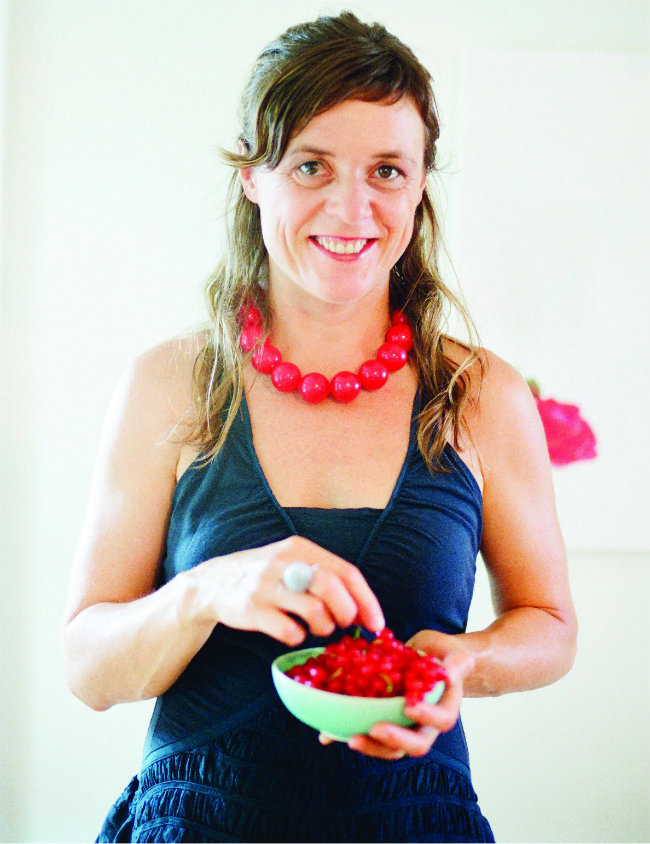
Béatrice Peltre is a food stylist, photographer and author of the award-winning food blog La Tartine Gourmande. In her latest book, My French Family Table, Béatrice presents the kind of colourful and wholesome French recipes that she serves up to her own family, blending traditional and contemporary tastes in unfussy fashion. She is also a firm believer in involving children in the kitchen from a young age and devotes a chapter to cooking with her daughter, Lulu. France Today asked her about her culinary ethos and to share some recipes.
France Today: What is your earliest food memory, and your favourite dishes from childhood?
Béatrice Peltré: Summer days with my mother and grandmother, preserving fruit and vegetables from their gardens. To this day, when summer arrives I think about those times when Lulu and I are in the garden together. My mother made a scrumptious hachis parmentier that I was always so excited to have her prepare when she had leftovers of a roast beef, and her cherry clafoutis and seasonal fruit tarts were also favorites.
FT: How did your childhood,your family food experiences, inspire your love and passion for cooking?
BP: Eating locally grown food was always a priority at home. It was easy because it just made sense with the tradition of keeping a vegetable garden. Being in the kitchen with my mother and watching her cook every meal influenced me tremendously – though I didn’t realize it then. It instilled in me a healthy relationship with food, and an understanding that we can show love when preparing meals.
FT: Your new book is all about cooking for your family. What inspired you to write it?
BP: My children. And my childhood memories of family meals. When I became a mother – and now that I am a mother of two young ones – I dreamed of writing a book that was strong on family food because living this life is what I do every day.
FT: What are the key ways to make healthy food tasty?
BP: Focus on quality ingredients. My cooking is healthy but I am not being excessive in that way because I believe more in enjoying everything in moderation, and embracing food for enjoyment and happiness. This is more generous.
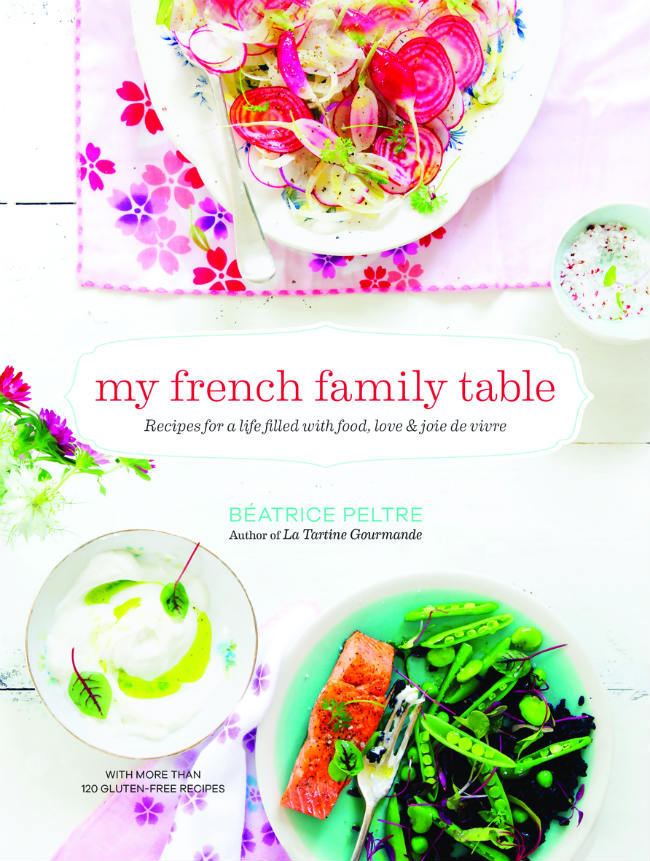
My French Family Table by Béatrice Peltre. Photo: White Loft Studio, Roost Books
FT: How has being a child of northeastern France influenced who you are, firstly as a Frenchwoman, and secondly as a cook?
BP: Well funny enough, even if I grew up in northeastern France, my food is more influenced by the south. My paternal grandparents, and many of my uncles and aunts, were all farmers, so that influences my way of thinking about food. This is where I organically learned about the farm-to-table concept. This is the way everyone cooked and ate.
FT: As a US resident, do you notice any differences in family meal times when compared to France?
BP: Yes, indeed. It’s clear that the French like to spend more time around the table. For the French, family meals are embedded in the daily routine. In the US, some families would rather make other activities a priority, and then eat on the go.
FT: You are an expert food stylist. Any tips for the amateur photographer capturing their own culinary creations on camera?
BP: Keep it simple, use natural light, and finish with delicate touches such as fresh herbs. Don’t try to force something in a photo (like flowers or a prop) if it does not make sense with the food.
FT: You have a huge Instagram following. How has social media changed the way our food experiences are shared?
BP: Because of my life as a mother and my profession as a food stylist and photographer, I have less time to blog. So a platform like Instagram is really gratifying since I can still share my daily inspirations with strong visuals and little words.
FT: What are the five most important ingredients at a chef’s disposal? Favourite meat, fish and vegetable?
BP: In my kitchen, I’d keep a bottle of olive oil for cooking and a few other quality ones for dressing salads, plenty of fresh herbs, and dark chocolate. I love lamb, cod, and carrots (the taste of a homegrown carrot just dug out of the garden is the best).
FT: A recent survey revealed that the most popular dish in restaurants across France is le burger. What do you make of this?
BP: It all depends on the burger, right? When a burger is made with great ingredients, it can be delicious. That said, a burger is a dish I eat very rarely so this comes as a surprise.
FT: I’m coming round to yours for dinner (thanks for the invite!). What dish would you cook for me that sums up your culinary ethos?
BP: One of my risottos, like the saffron-flavored carrot risotto from my book. Topped with sautéed bay scallops, chopped pistachios and basil oil. And served with my fennel, radish, and apple salad with truffle salt on the side. And to finish, a strawberry clafoutis.
FT: Which person, living or dead, would you have cook you your fantasy meal for you, and what would be on the menu?
BP: My daughter. Whatever she decided to cook for me.
FT: And finally, you are granted three wishes to change gastronomic life – the nation’s food habits – in France. What would they be?
BP: Keep the traditional methods and recipes alive. Instead of building a meal around meat or fish, focus more around a vegetable ingredient or dish. I think about my cooking in this way. Also, strengthen the culture of breakfast with more variety, proteins and healthy options to start the day.
FT: How important is it to engage children in cooking?
BP: Extremely important. It shows them the path from ingredients to the dishes they eat. Children are more inclined also to try new things when they participate in the preparation. It helps them feel engaged and proud of their accomplishments.
Recipes and photography (White Loft Studio) from My French Family Table by Béatrice Peltré © 2016 by Béatrice Peltré. Reprinted by arrangement with Roost Books, an imprint of Shambhala Publications, Inc. Boulder, CO. www.roostbooks.com
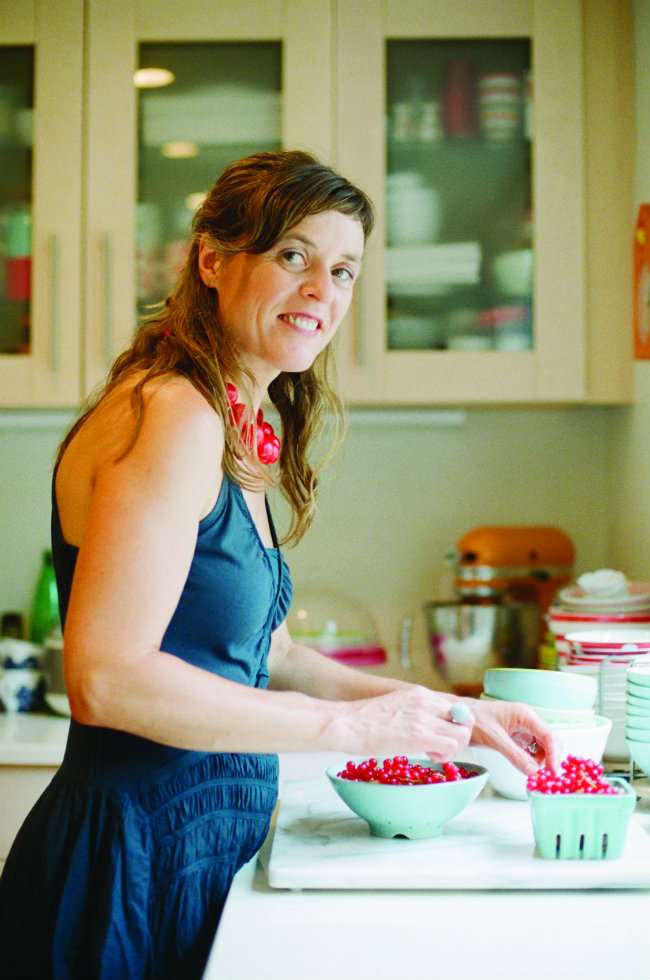
Béatrice Peltre. Photo: White Loft Studio, Roost Books
Brioche-Like Bread, Pain Brioché
Makes one 10-inch loaf | You will need: a 5 1/2 by 10 1/4 inch (14 by 26 cm) loaf pan.
Preparing this delectable bread makes the house smell sweet and delicious. It’s most enjoyable on the day you make it, but if you are lucky enough to have some left – we rarely do – slice it into thick pieces and toast them the next day. Or use leftovers to prepare the Blackberry and Raspberry Bread Puddings or to make croutons for a soup or a French Green Bean Salad.
Ingredients
Unsalted butter, for the pan, plus
4 tablespoons (2 oz; 60 g), melted
1 tablespoon (1/3 oz; 10 g) active dry yeast
2 teaspoons blond cane sugar
3/4 cup (180 ml) whole or 2% milk, heated to 110 degrees Fahrenheit (43 degrees Celsius)
1 cup (5 1/2oz; 160 g) brown rice flour
1 cup (3 1/2 oz; 100 g) gluten-free oat flour
1 cup (4 1/4 oz; 120 g) cornstarch
1/3 cup (1 1/2 oz; 40 g) tapioca starch
1 teaspoon sea salt
1 batch Flax Gel – See below
1/4 cup (60 ml) honey
3 large eggs, at room temperature
1 Butter the loaf pan; set aside.
2 In a small bowl, combine the yeast with the sugar. Stir in the warm milk until the yeast is dissolved. Let it rest for 10 to 15 minutes – the yeast will become active and frothy.
3 In the bowl of a stand mixer fitted with the paddle blade, mix together the brown rice flour, oat flour, cornstarch, tapioca starch, and sea salt. Leaving the machine on, add the flax gel and mix on medium speed until incorporated. Pour in the yeast mixture and continue to blend until incorporated. Add the melted butter and honey; continue to mix. Add the eggs, one at a time, waiting until the first one is well incorporated before adding the next.
4 The dough will be wet and runny. Pour the batter into the buttered bread pan and cover with a clean kitchen towel. Let rise in a warm, non-draughty part of the house, between 75°F and 85°F (24°c-29°c), for 60 to 90 minutes, or until the dough fills the pan. If the dough touches the towel, remove it.
5 Preheat the oven to 400°F (200°c). Bake the bread for 10 minutes. Reduce the heat to 350°F (180°c) and bake for another 30 minutes, or until a skewer inserted in the middle of the pain brioché comes out dry and the top is golden brown in color. remove from the oven and let rest for 5 minutes.
6 Run the blade of a knife around the edge of the pan, then flip the pan onto a working surface. Place the pain brioché on a cooling rack and leave to cool for at least 20 minutes before slicing. The bread is best on the day it is baked, of course, but it also keeps well for two to three days when wrapped in a kitchen towel.
Flax Gel
I like to call this gel the “magic bind”. I use it to prepare my tart crusts as it makes them very easy to roll (besides the addition of welcoming nutrients), and I also add it inside recipes such as the Kale and Pea Pancakes.
Ingredients
2 tablespoons golden flax meal
1/3 cup (80 ml) hot water
Put the flax meal in a small bowl and whisk in the hot water. Let rest for 15 minutes; the mixture will become gelatinous; set aside. I don’t recommend making this ahead and storing it; it’s really simple and fast to make as needed.
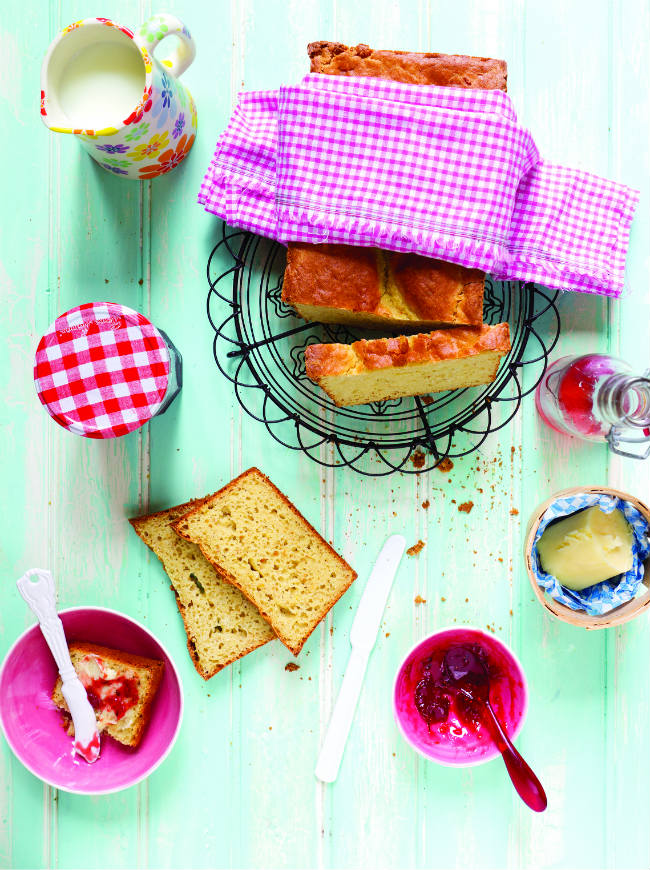
Brioche-like bread, My French Family Table. Photo: White Loft Studio, Roost Books
Vegetable tart with Pear and Roquefort and an Endive Salad
Tarte fine aux Légumes, aux Poires et au Roquefort, avec une Salade aux Endives
Serves 4 (2 slices each) | You will need: one 11 inch (28 cm) tart mold
This autumnal vegetable tart beckons with thin slices of potatoes, celeriac, and zucchini finely layered with pear and pieces of Roquefort. I use perfectly ripe pears to add extra sweetness to contrast with the sharp and tangy flavor of the cheese. The endive salad on the side is a perfect choice to complete your meal; if you would prefer to serve a rather more basic salad, you can simply toss 4 cups of arugula with 4 tablespoons of Everyday Salad Dressing with Shallot.
Ingredients
For the tart:
1 tablespoon (1/2 oz.; 14 g) whole hazelnuts
2 red potatoes (7 oz; 200 g), thinly sliced with a mandoline
3 1/2 oz (100 g) cleaned celeriac, thinly sliced with a mandoline
Rustic Crust with Teff Flour or Savory Crust with Hazelnut
3 large eggs, lightly beaten
1/4 cup (2 oz; 60 g) crème fraîche
1 tablespoon whole or 2% milk
1 teaspoon finely chopped thyme
1 tablespoon finely chopped parsley
1 1/2 oz (40 g) Manchego cheese or Comté cheese, grated
Sea salt and pepper
5 1/4 oz (150 g) zucchini, thinly sliced with a mandoline
1 ripe red pear, cored, and thinly sliced
1 1/2 oz (40 g) Roquefort cheese or Gorgonzola cheese, crumbled
Drizzle of honey (optional)
For the endive salad:
2 tablespoons butter
1/2 cup (1 3/4 oz; 50 g) whole pecans
1 tablespoon clover honey
A dash of ground paprika
A dash of fleur de sel
2 red Anjou pears
A dash of cinnamon
2 heads of endive
2 cups green salad leaves or mache (lamb’s lettuce)
1/4 cup (60 ml) Everyday Salad Dressing with Shallot
2 3/4 oz (80 g) crumbled Roquefort cheese (You can also use cranberry and crumbled goat cheese.)
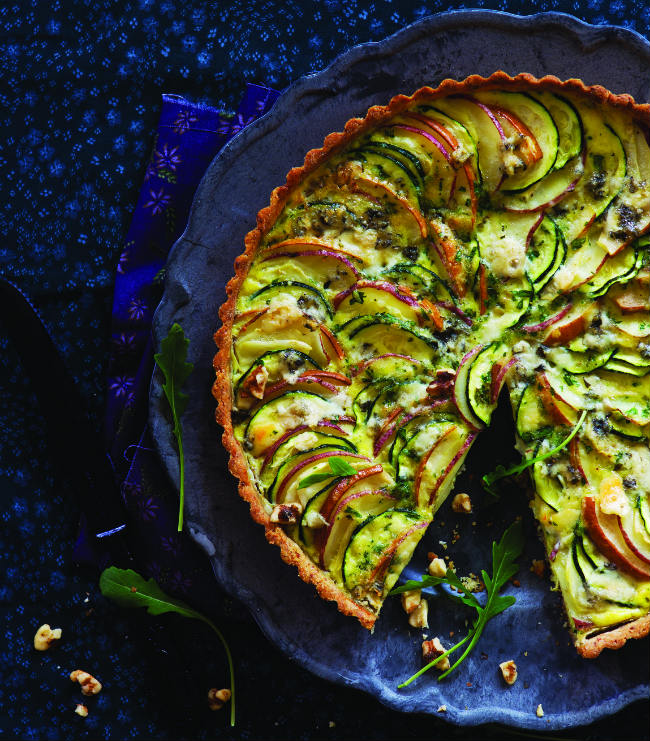
Vegetable tart, My French Family Table. Photo: White Loft Studio, Roost Books
1 To make the tart: in a nonstick frying pan, roast the hazelnuts over medium heat for 1 to 2 minutes, until fragrant. Remove from the heat and transfer to a kitchen towel; rub the nuts with the towel until the skins come off. Chop coarsely, then set aside.
2 Preheat the oven to 375°F (190°c). Blanch the potato and celeriac slices in salted boiling water for 3 minutes. Transfer to an ice water bath to cool; drain and set aside.
3 Roll and cut the crust to fit the mold. Arrange the dough inside the mold and, using a fork, make small holes in the bottom. Blind bake the crust for 10 minutes. Remove from the oven, and take out the parchment paper and weights; set aside.
4 Meanwhile, in a bowl, beat together the eggs, crème fraîche, and milk. Stir in the thyme, parsley, and Manchego cheese. season with sea salt and freshly ground black pepper.
5 Arrange the sliced vegetables and fruit in the crust in alternating layers, following this order: potato, celeriac, zucchini, and pear. Repeat until you run out of ingredients. Pour the egg mixture over the vegetables, and scatter the Roquefort cheese on top. Drizzle a little honey (if using) on top, to taste. Bake the tart in the oven for 25 to 30 minutes.
6 Top the tart with the chopped roasted hazelnuts. Let cool slightly before slicing, and serve with the endive salad on the side.
7 To prepare the endive salad: preheat the oven to 375°F (190°c). Line a baking sheet with parchment paper; set aside.
8 In a nonstick frying pan, melt 1 tablespoon of butter over medium heat. add the pecans and honey. Cook, stirring occasionally, for 1 to 2 minutes. Remove from the heat and transfer the pecans to the baking sheet; and sprinkle with paprika and fleur de sel. Bake for about 10 minutes, checking that the nuts do not burn. Remove from the oven and transfer to a plate to cool; set aside.
9 Wash, peel, and core the pears. Quarter them, then cut them in half again. Toss lightly with cinnamon to coat. heat the remaining tablespoon of butter in the same pan you used for the nuts, and add the pears to the pan. Cook on medium to high heat for 2 minutes on each side until tender but not brown. Remove from the heat and set aside.
10 Cut the yellow leaves from the base of the endive heads. Place the endive leaves in a large bowl (you can slice them into sticks if you prefer). Add the mixed greens or mâche, and toss with the dressing. Divide the salad between plates and add slices of pears, the caramelized pecans, and cheese to each plate.
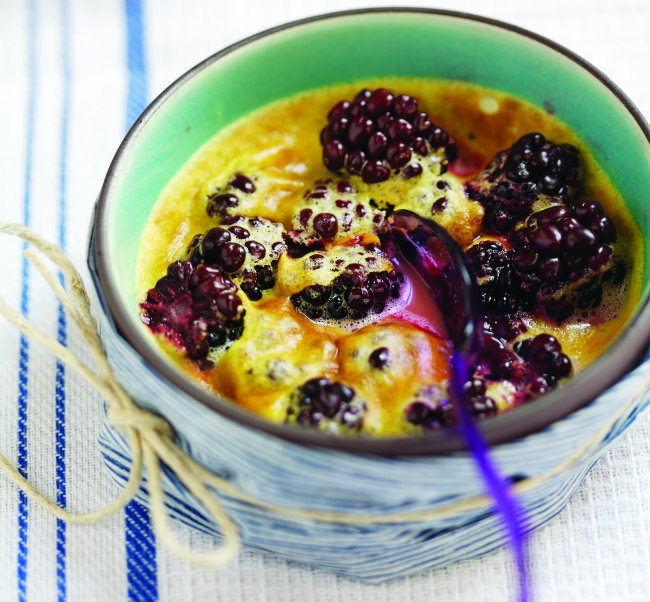
Blackberry saboyan gratins, My French Family Table. Photo: White Loft Studio, Roost Books
Blackberry Sabayon Gratins, Sabayons Gratinés aux Mûres
Serves 4 | You will need: four 4 1/2 by 1 1/4 inch (11.5 by 3 cm; 3/4 cup) ramekins.
Bushes of blackberries grow wild everywhere near my parents’ home in France. They conjure up the loveliest childhood memories of my mother and me picking buckets of them, with which we made jam and whatever else we fancied, like fruit tarts and small gratins similar to these. Here, I cover the berries with a silky sabayon made with apple juice and perfumed with rum for an adult twist on my childhood favorites. I suggest preparing the gratins ahead of time and placing them under the broiler (grill) a few minutes before you want to eat dessert. You can also make this dish with blueberries or raspberries.
Ingredients
For the fruit:
1 tablespoon (1/2 oz; 14 g) unsalted butter, plus more for ramekins
10 1/2 oz (300 g) blackberries
2 tablespoons pure cane sugar
Zest of 1/2 organic lime, finely grated
For the sabayon:
3/4 cup (175 ml) fresh apple juice
2 tablespoons rum
1 vanilla bean, split lengthwise and seeds scraped out
4 large egg yolks
1/3 cup (2 1/4 oz; 65 g) blond cane sugar
Confectioner’s sugar, to dust
1 Butter the ramekins; set aside. In a frying pan, melt the butter over medium heat. Add the blackberries and sprinkle with the sugar and lime zest. Cook for 2 minutes on each side. Remove from the heat and divide between the ramekins; set aside.
2 In a pot, combine the apple juice, rum, and vanilla bean and seeds. Bring to a simmer over low-medium heat. Remove from the heat, cover, and let infuse for 30 minutes. Strain and discard the vanilla; set aside.
3 In a bowl large enough to sit over a double boiler (bain-marie) without its bottom touching the water, beat the egg yolks with the sugar. Stir in the apple juice. Place over a pot of simmering water and cook, stirring constantly with a wooden spoon, until the cream thickens and coats the spoon – about 7 minutes. Remove from the heat and set aside.
4 Preheat the broiler. Pour the cream over the blackberries. Place the ramekins under the broiler for 1 to 2 minutes, or until the top starts to bubble slightly and turn golden brown in color – watch this last step carefully, as the broiling process can happen quickly and varies from one oven to another. Serve the gratins warm and dusted with confectioner’s sugar.
As seen in France Today magazine
Share to: Facebook Twitter LinkedIn Email
Leave a reply
Your email address will not be published. Required fields are marked *



